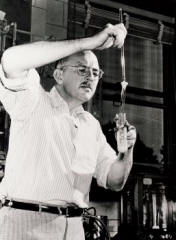Man Made Fibres and Blends
Rayon, the regenerated fibre developed in the late Victorian era was joined by a new kind of fibre also man made, but totally synthesised from chemicals found in the petrol industry. Synthetic fibres developed in the 1930s and 1940s, came into general use in the 1950s. Polyamide (Nylon), Polyester, Polyacrylonitriles (Acrylics), Polyolefins and Polyurethanes (Spandex, and Lycra) were all the rage in the 1950s and 1960s.Left - DuPont Chemist Julian Hill re-enacts his April 1930 cold drawing of the first superpolymer fibre.
 Right Wallace Carothers the inventor of Polyamide/Nylon.
Right Wallace Carothers the inventor of Polyamide/Nylon.Images courtesy of Dupont
Later combinations with natural fibres such as wool or cotton introduced the consumer to the concept of easy care fibre blends with a natural feel. Polycotton garments and the reduced costs of wool and acrylic mixed knits encouraged people to discard clothes more easily as clothes sewn with speedier operations could also be produced faster at less cost.
Viscose rayon was courted again in the 1980s, when there was the start of a reaction against synthetic fibres. Viscose crinkle fabrics and fabrics with exceptional drape or sheer effects wooed the consumer back.
By 2000 designers had caught on to adding Lycra or Spandex to fibres like viscose and acetate and created garments with great comfort and better shape retention in wear.
Chemists concentrated in improving all the man made fibres and by the 1980s, new variations which produced luxury look fabrics hit the marketplace. These improvements in fibre manufacture continue today and the buzzword for the 1990s was microfibres.
No comments:
Post a Comment